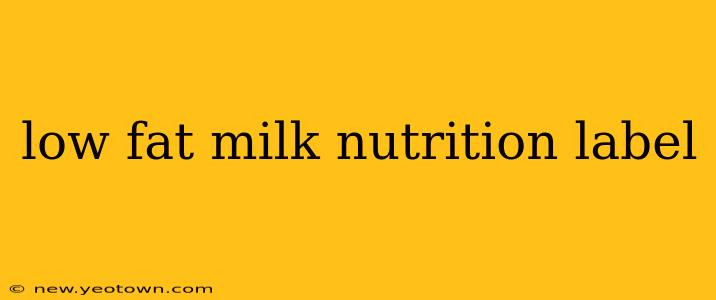Decoding the Low-Fat Milk Nutrition Label: A Creamy Tale of Nutrients
Let's be honest, navigating the labyrinth of nutrition labels can feel like deciphering an ancient scroll. But understanding what's in your low-fat milk is crucial, especially if you're watching your calorie intake or focusing on specific nutrients. This isn't just about numbers; it's about understanding how this everyday staple contributes to your overall health. Our journey begins with the label itself – let's unravel the mysteries together.
Imagine this: you're at the grocery store, faced with a wall of milk cartons. Each one boasts a slightly different label, promising various benefits. But how do you choose the right low-fat milk for your needs? This is where a deep dive into the nutrition label becomes essential. We'll break down the key components and address some frequently asked questions along the way.
What are the key nutrients in low-fat milk?
Low-fat milk is a powerhouse of essential nutrients. The exact amounts vary depending on the brand and the type of milk (e.g., skim, 1%, 2%), but generally, you'll find significant levels of:
- Calcium: Crucial for strong bones and teeth, calcium is a major player in low-fat milk. It supports bone health throughout your life, reducing the risk of osteoporosis later on.
- Protein: Milk provides high-quality protein, essential for building and repairing tissues. It contributes to satiety, helping you feel full and satisfied after a meal.
- Vitamin D: Often added to milk, vitamin D aids calcium absorption and supports bone health, immune function, and overall well-being. Many people don't get enough vitamin D from their diet alone, making fortified milk a convenient source.
- Riboflavin (Vitamin B2): This vitamin plays a role in energy production and red blood cell formation.
- Potassium: An important electrolyte, potassium contributes to maintaining healthy blood pressure.
How many calories are in low-fat milk?
The calorie count in low-fat milk is significantly lower than in whole milk. A typical serving (one cup) of skim milk (fat-free) contains around 80-90 calories, while 1% milk has slightly more. This makes it a suitable choice for those managing their weight or calorie intake. However, remember that added sugars in flavored varieties can significantly increase the calorie count. Always check the label for added sugars.
Is low-fat milk good for weight loss?
Low-fat milk can be a valuable part of a weight-loss diet. Its high protein content helps you feel full, reducing cravings and preventing overeating. The lower calorie count compared to whole milk also contributes to a calorie deficit, which is essential for weight loss. However, it's crucial to remember that weight loss is a multifaceted process that involves a balanced diet and regular exercise.
What are the differences between skim, 1%, and 2% milk?
The main difference lies in the fat content. Skim milk has virtually no fat, 1% milk has 1 gram of fat per serving, and 2% milk has 2 grams. The fat content influences the calorie count and the creaminess of the milk. Many people find 1% or 2% milk to strike a balance between taste and health benefits. The choice ultimately depends on individual preferences and dietary needs.
What are the health benefits of drinking low-fat milk?
Beyond the nutrients listed above, regular consumption of low-fat milk offers several potential health benefits:
- Stronger bones: The high calcium and vitamin D content contribute to bone health, reducing the risk of fractures and osteoporosis.
- Improved blood pressure: Potassium plays a role in maintaining healthy blood pressure levels.
- Weight management: The lower calorie and higher protein content can support weight management goals.
- Better muscle function: The protein content helps build and repair muscle tissue.
Remember, this information is for general knowledge and should not be considered medical advice. Consult a healthcare professional or registered dietitian for personalized dietary recommendations based on your individual needs and health status. The journey to understanding your low-fat milk nutrition label is a delicious and informative one. Armed with this knowledge, you can confidently navigate the grocery aisle and choose the milk that best supports your health and wellness goals.

